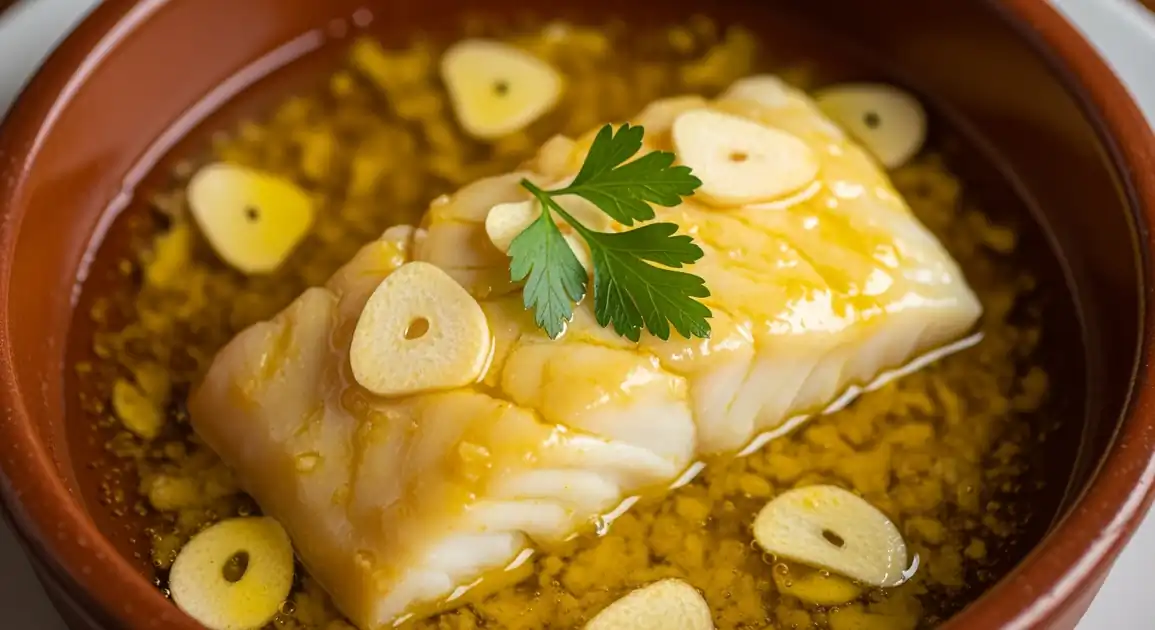Bacalao (Salted Cod)
Bacalao

Description
Bacalao is deeply ingrained in Spanish culinary tradition, found nationwide but with strong regional specialties, especially in the Basque Country, Catalonia, and Madrid. Its historical importance as a preserved food means it features heavily in inland areas and during traditional periods like Lent. Quality varies, so seeking out well-regarded establishments is recommended.
Dietary Information
Serving information
Serving style
Varies greatly: Served hot on plates ('raciones', mains), sometimes in earthenware 'cazuelas' (pil pil, vizcaína), as small bites on bread ('pinchos'), or simply fried pieces in paper cones/small plates (tapas).
Quick facts
Restaurants: Lunch (1 PM - 4 PM), Dinner (8 PM - 11:30 PM). Tapas Bars: Often open longer, from noon through late evening, peak times align with meals.
Safety Tips
What to Look For
-
Properly cooked fish: Opaque white flesh that flakes easily with a fork.
Ensures the cod is cooked through, reducing risks associated with undercooked fish.
-
Reputable establishment known for Bacalao
Restaurants or bars specializing in or famed for their cod dishes are more likely to handle and prepare it correctly (especially desalting).
-
Appears freshly prepared (especially fried items)
Fried bacalao should ideally be cooked to order or very recently fried to be crispy and hot, minimizing time in the temperature danger zone.
-
Balanced flavor (not overly salty)
Excessive saltiness indicates improper or insufficient desalting, which affects taste and potentially health.
-
Properly emulsified sauce (e.g., Pil Pil)
A well-made, stable emulsion suggests care in preparation, though not directly a safety issue, it indicates quality.
What to avoid
-
Overpowering salty taste
Suggests the cod was not desalted correctly. While not acutely dangerous for most, it's a quality failure and unpleasant.
-
Dry, tough, or stringy texture
Can indicate poor quality cod, improper storage/handling, or overcooking.
-
Any 'off' or excessively fishy smell
Salted cod should smell clean and mildly of the sea; strong unpleasant odors indicate potential spoilage.
-
Dishes sitting at lukewarm temperatures
Allows for bacterial growth. Ensure the dish is served properly hot (if cooked) or cold (if a cold preparation like Esqueixada).
-
Establishments with poor general hygiene
General cleanliness reflects overall food handling practices.
Price information
Price range
Budget tips
- Tapas portions ('tapa' or 'pincho') offer a taste for 3-6 EUR.
- 'Raciones' (larger sharing plates) typically cost 10-18 EUR.
- Full main courses in restaurants can range from 15 EUR to 30 EUR or more, depending on the venue and preparation.
- Market stalls can offer good value cooked portions.
Value indicators
- Proper desalting (not too salty).
- Firm, flaky texture.
- Well-executed sauce (e.g., emulsified pil pil).
- Crispy, non-greasy 'frito'.
- Generous portion size for the price.
Where to Find This Dish
Historic Quarters ('Casco Viejo')
Traditional bars and restaurants in old town areas often serve classic bacalao dishes.
Main squares ('Plaza Mayor'), Cathedrals, Old market areas
Lunch, Dinner
Market Halls ('Mercados')
Look for dedicated fish stalls ('bacaladerías') selling raw cod, or food stalls offering prepared dishes.
Mercado San Miguel (Madrid), La Boqueria (Barcelona), Mercado de la Ribera (Bilbao)
Daytime (market hours)
Tapas Streets/Areas
Concentrations of tapas bars often feature bacalao among their offerings.
Calle Laurel (Logroño), El Tubo (Zaragoza), La Latina (Madrid)
Evening, Weekend Lunchtime
Vendor Tips
- Look for signs indicating 'Especialidad en Bacalao' (Specialty in Cod).
- Basque restaurants/bars often excel at Bacalao al Pil Pil and Vizcaína.
- In Madrid, seek out places famous for 'Soldaditos de Pavía' or 'Bacalao Frito'.
- Don't be afraid to ask about the preparation if unsure.
How to Order
Regional Variations
-
Bacalao al Pil Pil
(Bacalao al Pil Pil)
Iconic Basque dish. Salt cod cooked gently in olive oil with garlic, whose gelatin emulsifies the oil into a thick, pale sauce.
-
Bacalao a la Vizcaína
(Bacalao a la Vizcaína)
Cod cooked in a sauce made from onions and red 'chistorra' peppers (or 'pimientos choriceros'), sometimes with tomato. Common in the Basque Country and beyond.
-
Bacalao Frito / Soldaditos de Pavía
(Bacalao Frito / Soldaditos de Pavía)
Strips or chunks of desalted cod, often battered ('rebozado') and deep-fried until golden and crisp. 'Soldaditos' are a classic Madrid tapa, sometimes served with a strip of red pepper.
-
Potaje de Vigilia
(Potaje de Vigilia)
'Lent Stew'. A traditional hearty stew eaten during Lent, featuring bacalao, chickpeas, spinach, garlic, and often hard-boiled eggs.
-
Esqueixada de Bacallà
(Esqueixada de Bacallà)
Catalan salad made with shredded raw desalted cod ('esqueixat' means 'torn'), tomatoes, onions, olives, and olive oil. (Note: Raw preparation).
-
Bacalao con Tomate
(Bacalao con Tomate)
Cod cooked in a simple, rich tomato sauce, often with garlic and onions.
-
Tortilla de Bacalao
(Tortilla de Bacalao)
A flat omelet (like a frittata) made with desalted cod pieces, onions, garlic, and parsley. Popular in Basque cider houses ('sidrerías').
Cultural context
History
The tradition of consuming salted cod in Spain dates back centuries, linked to Basque whaling and fishing expeditions in the North Atlantic. Salting was an effective preservation method allowing cod to be transported far inland and consumed year-round. It became deeply integrated into the cuisine, especially vital during Catholic Lent ('Cuaresma' or 'Semana Santa') when meat was restricted, leading to famous dishes like 'Potaje de Vigilia'.
Local significance
Bacalao is more than just fish; it's a symbol of Spanish history, resourcefulness, and religious tradition (Lent). It connects coastal fishing heritage with inland cuisine.
Eating customs
- Often shared as 'raciones'.
- Pil Pil sauce is traditionally mopped up with bread.
- Consumed year-round, but especially revered during specific cultural periods.